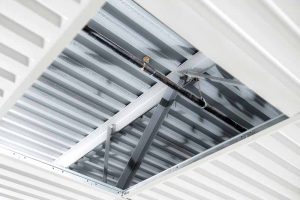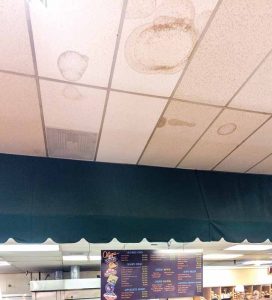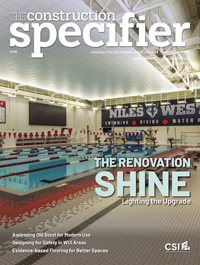Meeting ceiling requirements in restaurant settings

In restaurants with fire suppression sprinkler systems, some thermoformed panels have an unusual advantage. They comply with NFPA 13, Standard for the Installation of Sprinkler Systems, 3.3.61: “Drop-Out Ceiling. A suspended ceiling system, which is installed below the sprinklers, with listed translucent or opaque panels that are heat sensitive and fall from their setting when exposed to heat.”
Sprinklers can be installed above the ceiling plane and out of sight when the grid is populated with drop-out panels. In case of fire, heat causes thermoformed panels to soften, deform, and drop out of the grid and allows sprinklers to function. Drop-out panels enable the designer to avoid the visual intrusion of sprinkler heads on the ceiling; in luminous ceilings, they also avoid the shadows sprinklers might cast on a luminous panel. Drop-out panels reduce the cost of sprinkler installation by allowing the sprinkler layout to be optimized and by simplifying trade coordination. Similarly, perforated metal panels with at least 70 percent open area can also be installed beneath sprinklers (Figure 2).
Back-of-house needs
In the back-of-house—areas not generally accessible by dining patrons—aesthetics are not usually the driving force in design. The required performance of the ceiling has more to do with supporting the functions of the staff: food preparation and service in an environment that is clean, hygienic, and safe to work in.
Cleanliness
Behind the scenes of a restaurant, hygiene is top priority in food preparation areas. Health Codes require a ceiling that is cleanable and non-absorbent in food preparation areas. Cooking has been identified as a significant source of indoor air pollution, and grease, smoke particulate, and stains from foods such as red wine, mustard, and cooking oil are tough to remove. Finishes must withstand water, cleansers, and degreasing agents, as well as the scrutiny of public health officials.
Commercial kitchens generally have overhead fire suppression systems, exhaust fans, pipes, and ductwork upon which grime can accumulate and then fall into food. Such a situation would fall afoul of the general requirement for sanitary conditions. A drop-in suspended ceiling (if it does not interfere with a sprinkler system) can block such contaminants from coming into contact with, or falling from, the overhead services, while still leaving services accessible for maintenance.

Moisture management
Food preparation areas can be humid and wet environments. They are prone to condensation and leaks through the numerous roof penetrations for plumbing and venting. Finishes should be non-absorbent and resistant to sagging and the growth of mold and bacteria.
Conventional mineral fiber panels are absorbent, and once wetted, can sag (Figure 3). The exposed surface of vinyl-faced mineral fiber and gypsum board panels are washable, but they can still absorb moisture from above and through their edges.



